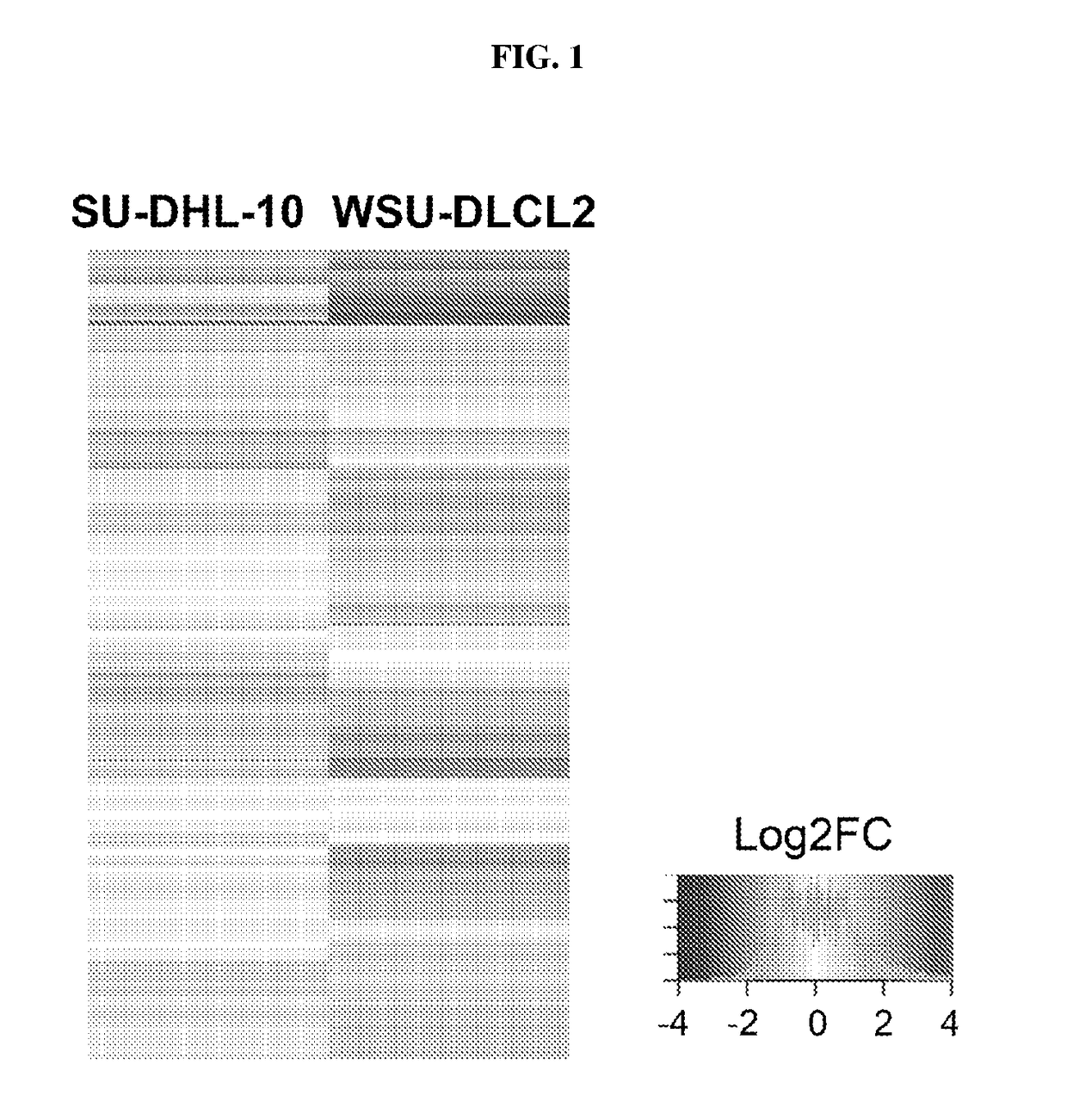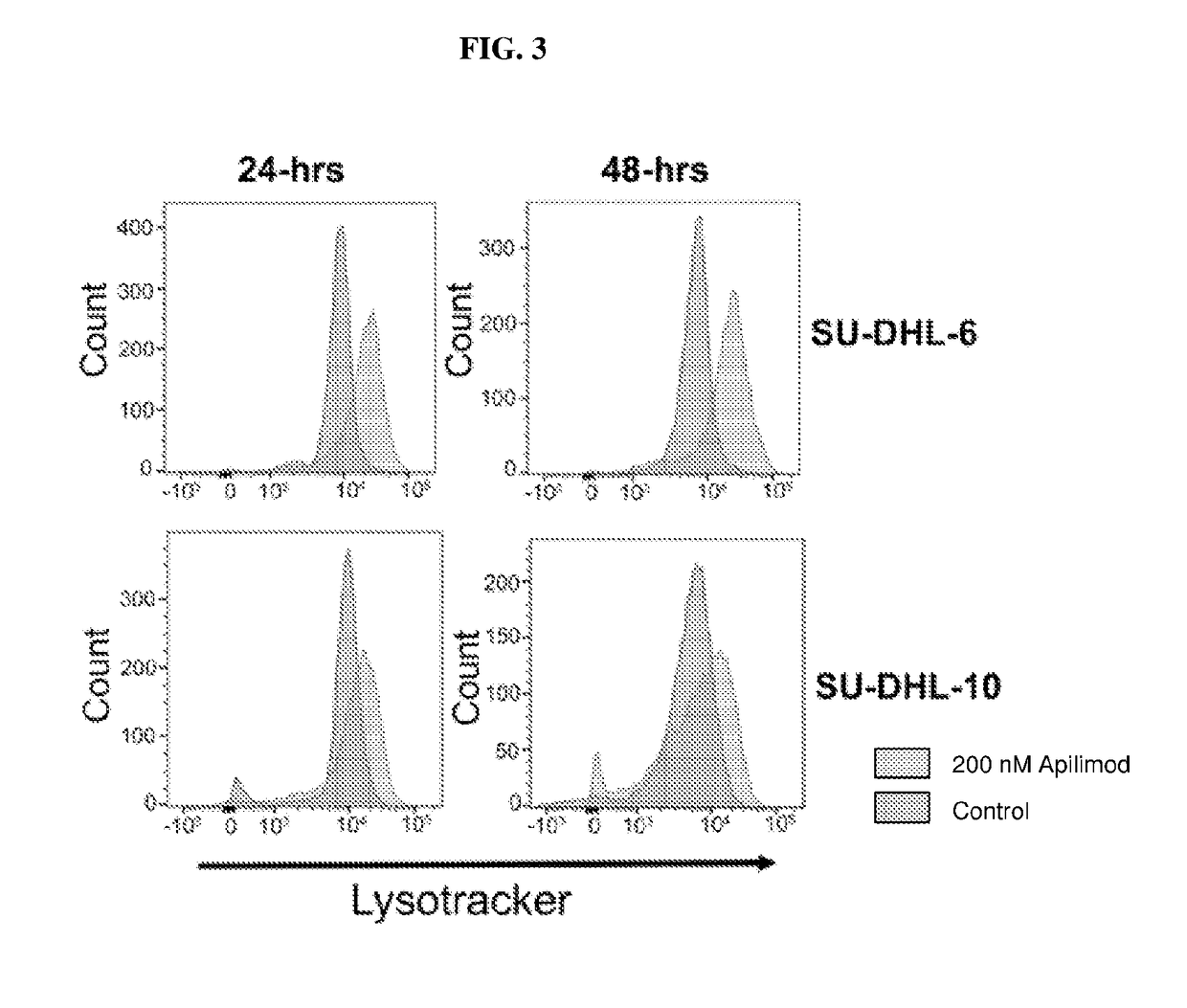Biomarkers for Treating Cancer with Apilimod
a technology of apilimod and biomarkers, which is applied in the direction of antineoplastic agents, organic active ingredients, drug compositions, etc., can solve the problems of limited therapeutic efficacy, apilimod did not demonstrate the efficacy over placebo, and translates into clinical improvement, so as to promote aberrant cell proliferation and increase apoptosis
- Summary
- Abstract
- Description
- Claims
- Application Information
AI Technical Summary
Benefits of technology
Problems solved by technology
Method used
Image
Examples
example 1
ers Sensitivity to Apilimod
[0147]We have previously shown that apilimod is a highly cytotoxic agent in TSC null cells. In these cells, the mTOR pathway is constitutively active, as it is in a number of cancers. A screen of over 100 cancer cell lines showed that apilimod was cytotoxic in diverse types of cancers. Our results further indicated that the cytotoxic activity of apilimod was due to inhibition of intracellular trafficking and a corresponding increase in apoptosis and / or autophagy.
[0148]To further understand apilimod's cellular mechanism of action, we performed a global gene expression analysis of the changes occurring after apilimod treatment of two non-Hodgkins B cell lymphoma (B-NHL) tumor cell lines, SU-DHL-10 and WSU-DLCL2. FIG. 1 shows a heatmap representation of the gene expression changes. Up-regulated genes are represented by red and are clustered toward the top of the heatmap while down-regulated genes are represented by blue and cluster towards the bottom. We next...
example 2
almia (MiT) Transcription Factors in Cancer
[0152]TFEB is a member of the MiT family of basic helix-loop-helix leucine zipper transcription factors, a family which also includes the highly homologous genes MITF, TFE3, and TFEC (Fisher et al. 1991). MITF is the most well characterized member of this family and is a master regulator of melanocyte biogenesis as well as an established driver of melanoma and clear cell sarcoma (Steingrimsson et al. 2004; Garraway et al. 2005; Davis et al. 2006). TFEB and TFE3 overexpression through chromosomal translocation are implicated in renal cell carcinogenesis, and TFE3 overexpression is further implicated in alveolar soft part sarcoma and perivascular epitheloid cell tumors (reviewed in Haq et al. 2011; Kauffman et al. 2014). TFEC expression is limited to macrophages, and is the least studied MiT family member, with little known about its function (Rehli et al. 1999). Members of the MiT family are known to regulate endolysosomal and autophagosome ...
example 3
l Carcinoma
[0153]TFEB, TFE3 and MITF have each been implicated in renal carcinogenesis by altering kidney cell metabolism in concert with other genes frequently mutated in renal cell carcinomas (RCCs) such as VHL, MET, FLCN, fumarate hydratase, succinate dehydrogenase, TSC1 and TSC2 (Linehan 2012). TFEB and TFE3 translocations resulting in overexpression and nuclear localization of functional transcription factor occur in translocation carcinomas, a rare RCC subtype accounting for 1-5% of sporadic RCCs (Shuch et al. 2015). Furthermore, a novel oncogenic MITF fusion gene, ACTG1-MITF was identified RCC (Durinck et al, 2015). Finally, germline missense mutations of MITF resulting in increased transcriptional activity have been reported in both melanomas and RCCs (Bertolotto et al. 2011).
[0154]RCCs are the most common type of kidney cancer in adults, accounting for 2-3% of adult malignancies and 90-95% of neoplasms arising from the kidney (Cancer Facts and Figures 2015). There are appro...
PUM
| Property | Measurement | Unit |
|---|---|---|
| Molar density | aaaaa | aaaaa |
| Molar density | aaaaa | aaaaa |
| Molar density | aaaaa | aaaaa |
Abstract
Description
Claims
Application Information
 Login to View More
Login to View More - R&D
- Intellectual Property
- Life Sciences
- Materials
- Tech Scout
- Unparalleled Data Quality
- Higher Quality Content
- 60% Fewer Hallucinations
Browse by: Latest US Patents, China's latest patents, Technical Efficacy Thesaurus, Application Domain, Technology Topic, Popular Technical Reports.
© 2025 PatSnap. All rights reserved.Legal|Privacy policy|Modern Slavery Act Transparency Statement|Sitemap|About US| Contact US: help@patsnap.com



